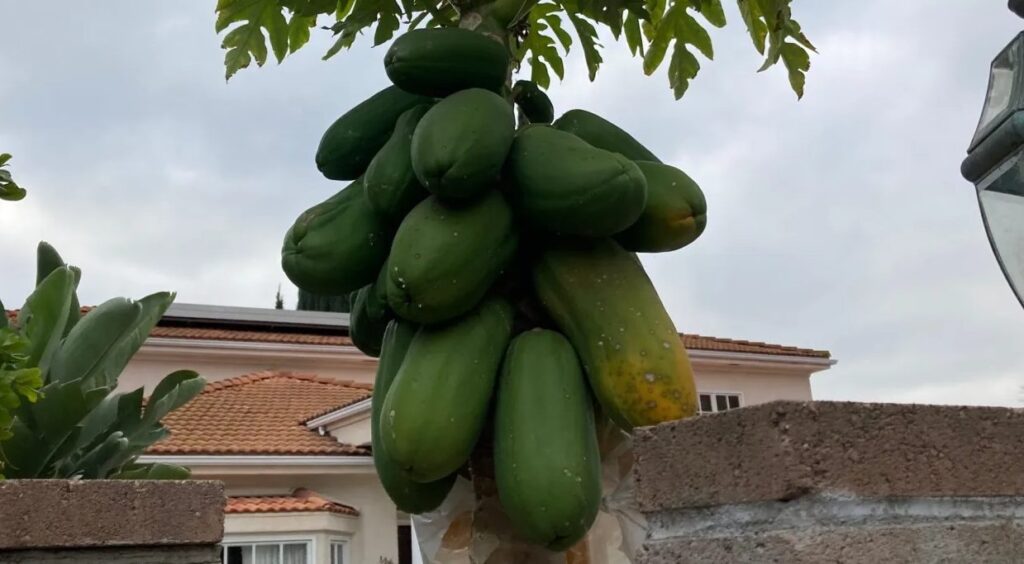
5 things to do in the garden this week:
1. Cherimoyas, mangoes, and papayas are the only commonly available fruit whose seeds grow into trees with fruit that is, as we say, true to type. However, whereas you will need to wait 5-8 years from planting a mango seed to see fruit and wait 3-4 years for a cherimoya to do the same, a papaya seed will shoot up into a tree that will bear fruit only 6-12 months after planting. Papaya trees will die in a frost but they may be grown successfully from Granada Hills to San Bernardino and everywhere south of the line between those two points.
After removing the aril (fluid bubble) around the seed, allow it to dry out, and then immediately plant it barely beneath the soil surface. You can also order papaya seeds from online vendors Native to the tropics of Mexico and Central America, a papaya tree may be male, female, or bisexual. (Note: the vast majority of plants are bisexual, having both male and female flower parts.) However, commercial papaya orchards are invariably planted to bisexual trees and it is their fruit that you see in the market. The seeds from this fruit will grow into either bisexual or female trees but you will not know which you have until flowers develop.
It is thus a common practice to germinate a group of seeds in containers and to select the self-fertile, bisexual seedlings once their flowers bloom, for planting out in the garden. Pollination of papaya trees, incidentally, is both by wind and insects, with hawkmoths – the adults of tomato hornworms – assisting in the process.
2. If you want your fig tree to produce heavy crops year after year, cut back almost all of last year’s new growth if you have not done so already. The results of doing this will give you a tree of a manageable size where no ladders are needed to harvest the fruit, even while the quantity of your harvest will be significant.
3. Mock orange (Philadelphus coronarius) may be the most fragrant of all flowering plants. It requires half-day sun and, once established, is rather drought-tolerant. Every year at this time, thousands of blossoms open, each lasting for a few days. The total period of bloom is not long, barely lasting a month, but the experience is as memorable as it is brief. You seldom see mock orange in nurseries or garden centers. Perhaps its deciduous nature, its relatively brief bloom period, or the fact that, in our climate, it is more sun sensitive than most plants. Meanwhile, you can find it in the nursery trade here and there and it is available through Internet vendors.
4. I planted a single African corn flag (Chasmanthe floribunda) plant a few years ago and it is now flowering throughout my garden. Native to South Africa, it reproduces by corms and seeds. Its desire to grow is powerful as its seeds found their way into my parkway and shot up right through two feet of lantana thatch. Orange-red in color, the African cornflag now makes a fitting complement to the yellow and orange lantana varieties that cover the parkway. Its flower wands consist of 20-40 paired and curving blooms that hold up in a vase for up to two weeks. This plant has naturalized in the San Francisco area, meaning it has jumped the garden fence and escaped into the wild, although I have not seen it in any of our local wilderness areas. It will remind you of Montbretia (Crocosmia), a fall bloomer and close relative of African flag. Plant its seeds together with larkspur and hollyhock seeds for a triumvirate of self-sowing, naturalizing beauties that soar up to five feet or more into the air.
Related Articles
5 smart money tips to help you spring clean your pantry budget
Gardening: There’s a new tomato that’s sun-dried on the vine
Daffodils, petunias and more: 5 things to do in the garden this week
All about pomelos, pomelitos, grapefruits and other citrus fruits
How to grow budget-friendly groceries indoors and out
5. For a bright addition to the shade garden, plant variegated Hawaiian elf (Schefflera arboricola ‘Variegata’). The gold splotches in the foliage illuminate dark corners. To add texture to your shady retreat, plant Philodendron Xanadu. Its scalloped leaf margins provide a touch of whimsy that is a pleasant departure from the funereal formality often associated with shade-loving species. Keep in mind that shade plants require at least three hours of good ambient light to grow. Sometimes, a planter is so shady that nothing will grow in it and you are better off filling the space with ornamental stones or a small fountain.
You are invited to write to Joshua@perfectplants.com with any gardening tips or gardening problems that you would like to share.
